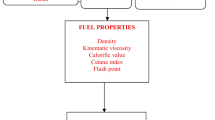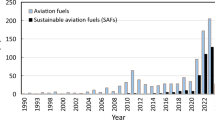Abstract
The twin crises in depletion of fossil fuels and environmental degradation have motivated researches to consolidate the use of biofuels for internal combustion engine applications. In the present study, the performance and emission characteristic of Calophyllum inophyllum oil-based methyl ester and its diesel blends are analyzed at various compression ratios. Comprehensive optimization by considering the performance parameter along with emission characteristic is rather involved and is done carefully with designed set of experiments and analyzed statistically using design expert software. Higher compression ratio (CR) induces high cylinder temperature which enhances vaporization and thereby better performance only to a certain extent, that is, up to a CR of 19. However, due to high operating temperature, the oxides of nitrogen emission increase with CR and also for high biofuel blends, but better combustion phenomenon at these conditions reduces the emissions of carbon monoxide and unburned hydrocarbon. The designed empirical statistical model for optimum performance with lower emission is found to be B30 (30 % biofuel) at a CR of 19, which is then tested and validated.
Similar content being viewed by others
References
Melvin Jose D.F., Edwin Raj R., Durga Prasad D., Robert Kennedy Z., Mohammed Ibrahim A.: A multi-variant approach to optimize process parameters for biodiesel extraction from rubber seed oil. Appl. Energy 88, 2056–2063 (2011)
Royon D., Daz M., Ellenrieder G., Locatelli S.: Enzymatic production of biodiesel from cotton seed oil using t-butanol as a solvent. Bioresour. Technol. 98, 648–653 (2007)
Sahoo P.K., Das L.M., Babu M.K.G., Naik S.N.: Biodiesel development from high acid value polanga seed oil and performance evaluation in a CI engine. Fuel 86, 448–454 (2007)
Li S., Wang Y., Dong S., Chen Y., Cao F., Chai F., Wang X.: Biodiesel production from Eruca Sativa Gars vegetable oil and motor, emissions properties. Renew. Energy 34(7), 1871–1876 (2009)
Qi D.H., Lee C.F., Jia C.C., Wang P.P., Wub S.T.: Experimental investigations of combustion and emission characteristics of rapeseed oil–diesel blends in a two cylinder agricultural diesel engine. Energy Convers. Manag. 77, 227–232 (2014)
Dhar A., Kevin R., Agarwal A.K.: Production of biodiesel from high-FFA neem oil and its performance, emission and combustion characterization in a single cylinder DICI engine. Fuel Process. Technol. 97, 118–129 (2012)
Ghadge S.V., Raheman H.: Process optimization for biodiesel production from mahua (Madhuca indica) oil using response surface methodology. Bioresour. Technol. 97, 379–384 (2006)
Naik M., Meher L.C., Naik S.N., Das L.M.: Production of biodiesel from high free fatty acid Karanja (Pongamia pinnata) oil. Biomass Bioenergy 32, 354–357 (2008)
Koberg M., Gedanken A.: Direct transesterification of castor and Jatropha seeds for FAME production by microwave and ultrasound radiation using a SrO catalyst. BioEnergy Res. 5, 958–968 (2012)
Ramadhas A.S., Jayaraj S., Muraleedharan C.: Characterization and effect of using rubber seed oil as fuel in the compression ignition engines. Renew. Energy 30, 795–803 (2005)
Buyukkaya E.: Effects of biodiesel on a DI diesel engine performance, emission and combustion characteristics. Fuel 89, 3099–3105 (2010)
Murillo S., Mı’guez J.L., Porteiro J., Granada E., Mora’n J.C.: Performance and exhaust emissions in the use of biodiesel in outboard diesel engines. Fuel 86, 1765–1771 (2007)
Desantes, J.M.; Arregle, J.; Ruiz, S.; Delage, A.: Characterization of the Injection–Combustion Process in a D.I. Diesel Engine Running with Rape Oil Methyl Ester, SAE 1999-01-1497, pp. 984–991 (1997)
Hamasaki, K.; Tajima, H.; Takasaki, K.; Satohira, K.; Enomoto, M.; Egawa, H.: Utilization of waste vegetable oil methyl ester for diesel fuel, SAE 2001-01-2021, pp. 1499–1504 (2001)
Jindal S., Nandwana B.P., Rathore N.S., Vashistha V.: Experimental investigation of the effect of compression ratio and injection pressure in a direct injection diesel engine running on jatropha methyl ester. Appl. Therm. Eng. 30, 442–448 (2010)
Dorado M.P., Ballesteros E., Arnal J.M., Gomez J., Lopez F.J.: Exhaust emissions from a diesel engine fueled with transesterified waste olive oil. Fuel 82, 1311–1315 (2003)
Rao, G.L.N.; Sampath, S.; Rajagopal, K.: Experimental studies on the combustion and emission characteristics of a diesel engine fuelled with used cooking oil methyl ester and its diesel blends. Int. J. Mech. Aerosp. Ind. Mechatron. Manuf. Eng. 2, 90–96 (2008)
Godiganur S., Murthy C.H.S., Reddy R.P.: 6BTA 5.9 G2-1 Cummins engine performance and emission tests using methyl ester mahua (Madhuca indica) oil/diesel blends. Renew. Energy 34, 2172–2177 (2009)
Sharma D., Soni S.L., Mathur J.: Emission reduction in a direct injection diesel engine fueled by neem-diesel blend. Energy Source Part A 31, 500–508 (2009)
Suresh kumar K., Velraj R., Ganesan R.: Performance and exhaust emission characteristics of a CI engine fuelled with Pongamia pinnata methyl ester (PPME) and its blends with diesel. Renew. Energy 33, 2294–2302 (2008)
Sahoo P.K., Das L.M., Babu M.K.G., Arora P., Singh V.P., Kumar N.R. et al.: Comparative evaluation of performance and emission characteristics of jatropha, karanja and polanga based biodiesel as fuel in a tractor engine. Fuel 88, 1698–1707 (2009)
Ganapathy T., Gakkhar R.P., Murugesan K.: Optimization of performance parameters of diesel engine with Jatropha biodiesel using response surface methodology. Int. J. Sustain. Energy 30, S76–S90 (2011)
Lapuerta M., Herreros J.M., Lyons L.L., García-Contreras R., Brice Y.: Effect of the alcohol type used in the production of waste cooking oil biodiesel on diesel performance and emissions. Fuel 87, 3161–3169 (2008)
Ahmed S., Hassan M.H., Abul Kalam Md., Ashrafur Rahman S.M., Joynul Abedin Md., Shahir A.: An experimental investigation of biodiesel production, characterization, engine performance, emission and noise of Brassica juncea methyl ester and its blends. J. Clean. Prod. 79, 74–81 (2014)
Nabi M.N., Akhter M.S., Shahadat M.M.Z.: Improvement of engine emissions with conventional diesel fuel and diesel–biodiesel blends. Bioresour. Technol. 97, 372–378 (2006)
Ashrafur Rahman S.M., Masjuki H.H., Kalam M.A., Abedin M.J., Sanjid A., Sajjad H.: Production of palm and Calophyllum inophyllum based biodiesel and investigation of blend performance and exhaust emission in an unmodified diesel engine at high idling conditions. Energy Convers. Manag. 76, 362–367 (2013)
Antony Miraculas, G.; Bose, N.: Effect of compression ratio on diesel engine performance and emission fueled with tamanu oil methyl ester and its blends. Adv. Mater. Res. 984, 850–854 (2014)
Raheman H., Phadatare A.G.: Diesel engine emissions and performance from blends of karanja methyl ester and diesel. Biomass Bioenergy 27, 393–397 (2004)
Wang Y., Zhao Y., Xiao F., Li D.: Combustion and emission characteristics of a diesel engine with DME as port premixing fuel under different injection timing. Energy Convers. Manag. 77, 52–60 (2014)
Ashrafur Rahman S.M., Masjuki H.H., Kalam M.A., Abedin M.J., Sanjid A., Imtenan S.: Effect of idling on fuel consumption and emissions of a diesel engine fueled by Jatropha biodiesel blends. J. Clean. Prod. 69, 208–215 (2014)
Antony Miraculas G., Bose N., Edwin Raj R.: Optimization of process parameters for biodiesel extraction from tamanu oil using design of experiments. J. Renew. Sustain. Energy 6, 033120 (2014)
Author information
Authors and Affiliations
Corresponding author
Rights and permissions
About this article
Cite this article
Miraculas, G.A., Bose, N. & Raj, R.E. Optimization of Biofuel Blends and Compression Ratio of a Diesel Engine Fueled with Calophyllum inophyllum Oil Methyl Ester. Arab J Sci Eng 41, 1723–1733 (2016). https://doi.org/10.1007/s13369-015-1942-0
Received:
Accepted:
Published:
Issue Date:
DOI: https://doi.org/10.1007/s13369-015-1942-0




